General definition of Iverson cut
The Iverson cut features action that occurs when an offensive player who is initially on one side of the court, usually near a wing area, cuts through to the other side, which is typically the opposite wing area.
Basic examples of Iverson cut
This section features basic examples of the Iverson cut via basketball diagrams.
Furthermore, each numbered offensive player on the diagrams within this section as well as subsequent sections below are represented by the standard basketball positions.
In essence, 1 and 2 are the point guard and shooting guard respectively.
3 and 4 are the small forward and power forward respectively.
Lastly, 5 represents the center position.
Basic Example 1
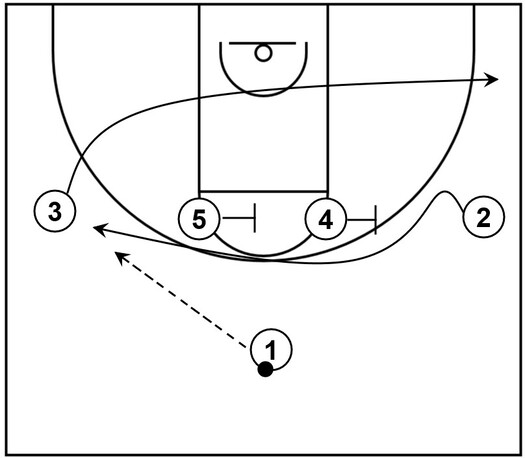
This is a basic example that showcases a typical version of the Iverson cut featuring screening actions near the high post area.
Additionally, this example is derived from a 1-4 high set. In terms of the initial setup: 1 is at the top in the middle of the floor with possession of the basketball; 2 and 3 are on the wings; 4 and 5 occupy the high post elbow areas.
2 executes the Iverson cut via a pair of high post screens set by 4 and 5 while 3 cuts through to the right side corner.
Afterwards, 2 receives the ball from 1 and has the opportunity to take an open jump shot or attack the rim if necessary.
It should also be noted that when one particular player on one side of the court performs the Iverson cut while another player simultaneously cuts through the lane to the opposite side, this is generally referred to as ‘Over Under’ action.
Essentially, one player cuts over the top, in this case with the Iverson cut, as well as over screens near the high post. At the same time, another player cuts under the Iverson cut action and/or under the screens near the high post.
Basic Example 2
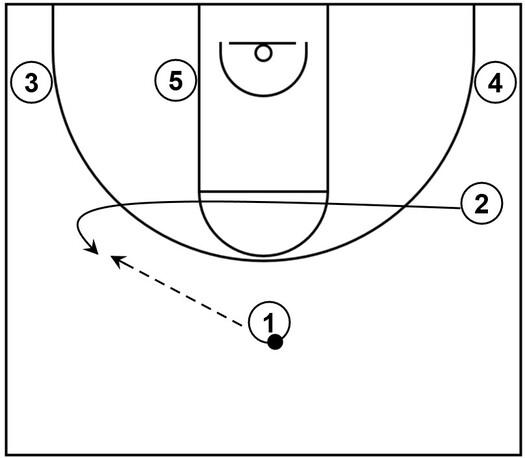
It is also possible, yet generally not as common, for an offensive player to perform the Iverson cut without screens as shown within this example.
In relation to the initial setup: 1 is at the top with possession of the ball; 2 is near the right side wing; 3 and 4 occupy the corners; 5 fills the left side low post area.
To begin, 2 executes the Iverson cut by moving across the high post areas from the right side wing to the left side wing.
Following that, 2 receives the ball from 1 and various offensive actions can occur such as an entry pass into the low post area or an on-ball screen near the wing set by 5, among other opportunities.
Basketball plays that feature the Iverson cut
These are examples of basketball plays with scoring options that feature the Iverson cut during the offensive action.
Play 1
Part 1: Iverson cut and through cut
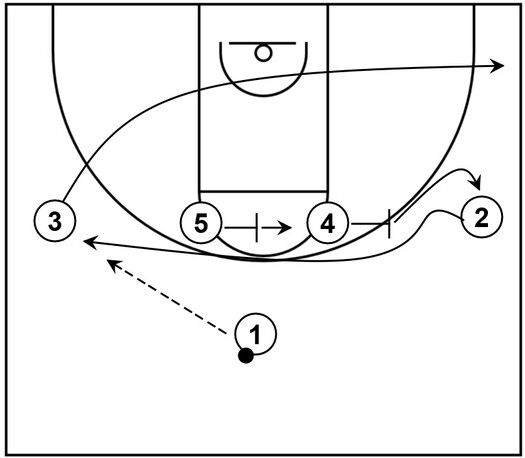
The initial setup for this play is a 1-4 high alignment with 1 at the top, 2 and 3 near the respective wings, as well as 4 and 5 near the respective high post elbows.
To begin the play, 2 moves across from the right side wing to the left side wing via the Iverson cut as well as by way of a pair of screens set by 4 and 5.
Furthermore, as that happens, 3 cuts through via the baseline to the right side corner.
Following that, 2 receives the ball from 1 while 4 pops out to fill the vacant right side wing and 5 stays near the middle of the high post area.
Part 2: Back screen
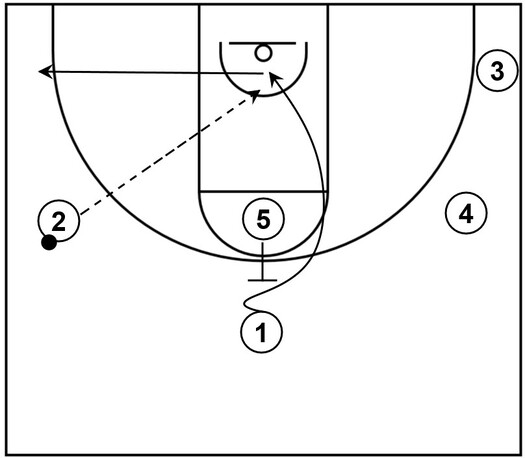
Next, 1 cuts to the basket by way of a back screen set by 5. From there, 1 could possibly receive the ball from 2 if that is open.
Otherwise, 1 cuts through to the left side corner.
Part 3: Spread pick and roll
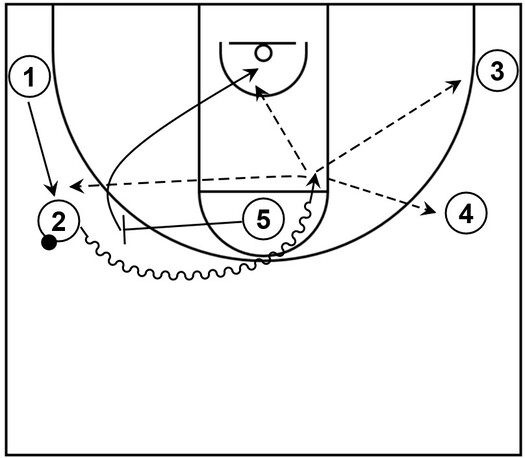
Following the Iverson cut and the back screen, the offensive team could segue into spread pick and roll action.
Essentially, 2 could dribble towards the middle and attack the rim by way of a pick that is set by 5 who also rolls to the basket.
Additionally, as 2 drives to the basket, shake action can happen in which 1 simply lifts up from the left side corner towards the adjacent left side wing.
From there, multiple scoring options are potentially available.
Basically, 2 can score at the rim, take the mid-range shot, or pass the ball to any of the other teammates depending on whoever is open to receive it.
Play 2
Part 1: Iverson cut and cross screen
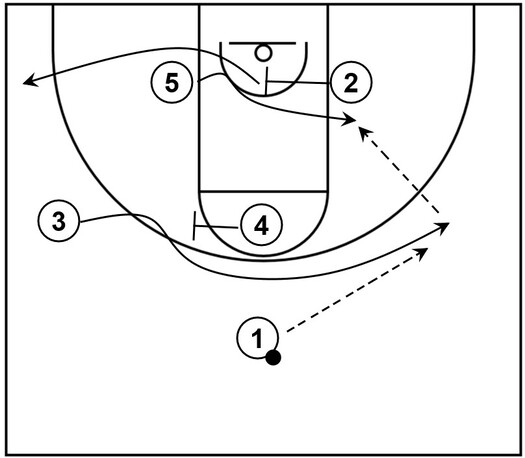
The initial setup for this play consists of 1 at the top in the middle of the floor, 3 on the left side wing, 4 at the high post area, 2 near the right side low post area, and 5 near the left side low post area.
To begin the play, 3 moves across the wings via the Iverson cut as well as by way of a screen set by 4.
Afterwards, 3 receives the ball from 1 and once that occurs, 5 cuts across to the right side low post area via a cross screen set by 2 who also pops out to the empty left side corner.
Following that, 5 could receive the ball from 2 and score by way of a low post move.
Part 2: Stagger screen
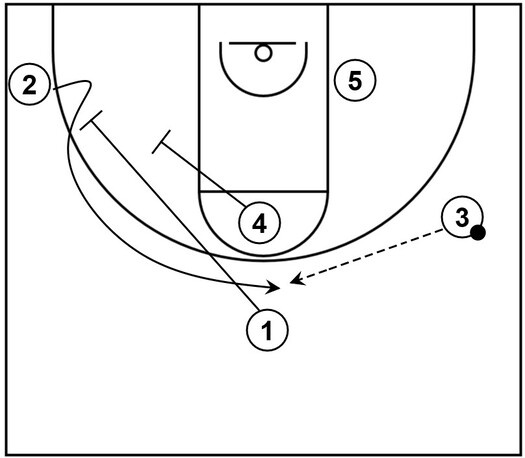
If 5 is not open to receive the ball, then 1 and 4 can set a stagger screen with 2 as the recipient.
From there, 2 could cut from the left side corner to the top, receive the ball from 3 and take the three-point shot if that is open.
Additional info about the Iverson cut
Name origin
The Iverson cut is named after and essentially popularized by NBA Hall of Famer, Allen Iverson, who would use this particular basketball cut to get open, especially near the wing areas of the court.
Related: Iverson Cut (AI Cut) – YouTube
General benefits
The Iverson cut is generally beneficial because it could be implemented to create various scoring or other playmaking opportunities near the basket or near the perimeter areas of the court.
For example, the Iverson cut could be utilized by an offensive team’s best mid-range or three-point shooter to get open for an immediate jump shot scoring opportunity.
Alternatively, the Iverson cut could be used by the offensive player with the best dribbling skills and/or slashing capability to attack the basket, which could also result in a scoring/playmaking option.
Furthermore, after an offensive player performs the Iverson cut, that may lead to isolation actions, which could also result in potential scoring or playmaking opportunities.
For example, let’s say that an offensive player receives the ball near the wing after executing the Iverson cut.
At the same time, let’s say that same player is now in a 1 on 1 isolation situation against their primary on-ball defender.
From there, the player in possession of the ball could be at a significant advantage if that same player has above average offensive skills and/or their primary defender has below average defensive skills.
Afterwards, the player with the ball could execute a series of dribbling moves such as a double crossover followed by a drive to the basket or a step back jump shot against the on-ball defender.
Nevertheless, in some instances, the on-ball defender could be at least average in terms of defensive skills.
If that is the case, then after carrying out the Iverson cut, the offensive player could initially receive the ball and set up in the triple threat position.
Following that, the offensive player could perform a simple action known as the jab step to open or change the defender’s stance and after that, that same player could then execute one or more dribble moves into a jump shot or drive for scoring/playmaking possibilities.
More resources
Iverson Cut Series- Best Plays – YouTube